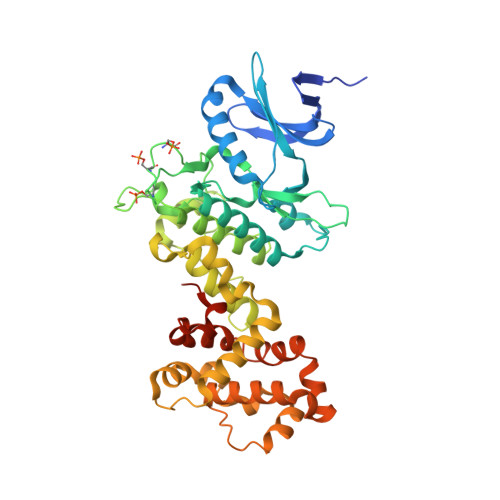Identification of BRaf-Sparing Amino-Thienopyrimidines with Potent IRE1 alpha Inhibitory Activity.
Beveridge, R.E., Wallweber, H.A., Ashkenazi, A., Beresini, M., Clark, K.R., Gibbons, P., Ghiro, E., Kaufman, S., Larivee, A., Leblanc, M., Leclerc, J.P., Lemire, A., Ly, C., Rudolph, J., Schwarz, J.B., Srivastava, S., Wang, W., Zhao, L., Braun, M.G.(2020) ACS Med Chem Lett 11: 2389-2396
- PubMed: 33335661
- DOI: https://doi.org/10.1021/acsmedchemlett.0c00344
- Primary Citation of Related Structures:
6XDB, 6XDD, 6XDF - PubMed Abstract:
Amino-quinazoline BRaf kinase inhibitor 2 was identified from a library screen as a modest inhibitor of the unfolded protein response (UPR) regulating potential anticancer target IRE1α. A combination of crystallographic and conformational considerations were used to guide structure-based attenuation of BRaf activity and optimization of IRE1α potency. Quinazoline 6-position modifications were found to provide up to 100-fold improvement in IRE1α cellular potency but were ineffective at reducing BRaf activity. A salt bridge contact with Glu651 in IRE1α was then targeted to build in selectivity over BRaf which instead possesses a histidine in this position (His539). Torsional angle analysis revealed that the quinazoline hinge binder core was ill-suited to accommodate the required conformation to effectively reach Glu651, prompting a change to the thienopyrimidine hinge binder. Resulting analogues such as 25 demonstrated good IRE1α cellular potency and imparted more than 1000-fold decrease in BRaf activity.
Organizational Affiliation:
Paraza Pharma Inc., 2525 Ave. Marie-Curie, Montreal, QC, Canada H4S 2E1.






















